The transpeptidase PbpA and noncanonical transglycosylase RodA of Mycobacterium tuberculosis play important roles in regulating bacterial cell lengths
- PMID: 29530985
- PMCID: PMC5925798
- DOI: 10.1074/jbc.M117.811190
The transpeptidase PbpA and noncanonical transglycosylase RodA of Mycobacterium tuberculosis play important roles in regulating bacterial cell lengths
Abstract
The cell wall of Mycobacterium tuberculosis (Mtb) is a complex structure that protects the pathogen in hostile environments. Peptidoglycan (PG), which helps determine the morphology of the cell envelope, undergoes substantial remodeling under stress. This meshwork of linear chains of sugars, cross-linked through attached peptides, is generated through the sequential action of enzymes termed transglycosylases and transpeptidases. The Mtb genome encodes two classical transglycosylases and four transpeptidases, the functions of which are not fully elucidated. Here, we present work on the yet uncharacterized transpeptidase PbpA and a nonclassical transglycosylase RodA. We elucidate their roles in regulating in vitro growth and in vivo survival of pathogenic mycobacteria. We find that RodA and PbpA are required for regulating cell length, but do not affect mycobacterial growth. Biochemical analyses show PbpA to be a classical transpeptidase, whereas RodA is identified to be a member of an emerging class of noncanonical transglycosylases. Phosphorylation of RodA at Thr-463 modulates its biological function. In a guinea pig infection model, RodA and PbpA are found to be required for both bacterial survival and formation of granuloma structures, thus underscoring the importance of these proteins in mediating mycobacterial virulence in the host. Our results emphasize the fact that whereas redundant enzymes probably compensate for the absence of RodA or PbpA during in vitro growth, the two proteins play critical roles for the survival of the pathogen inside its host.
Keywords: Lipid II; Mycobacterium tuberculosis; PbpA; RodA; bacterial pathogenesis; cell division; cell wall; peptidoglycan; transglycosylase; transpeptidase.
© 2018 by The American Society for Biochemistry and Molecular Biology, Inc.
Conflict of interest statement
The authors declare that they have no conflicts of interest with the contents of this article
Figures

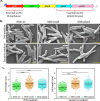
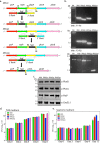
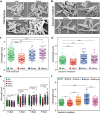
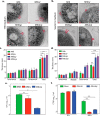
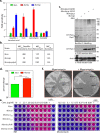
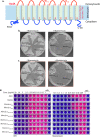
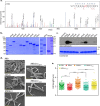
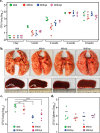
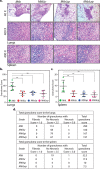
Similar articles
-
Nonclassical transpeptidases of Mycobacterium tuberculosis alter cell size, morphology, the cytosolic matrix, protein localization, virulence, and resistance to β-lactams.J Bacteriol. 2014 Apr;196(7):1394-402. doi: 10.1128/JB.01396-13. Epub 2014 Jan 24. J Bacteriol. 2014. PMID: 24464457 Free PMC article.
-
Cell Wall Damage Reveals Spatial Flexibility in Peptidoglycan Synthesis and a Nonredundant Role for RodA in Mycobacteria.J Bacteriol. 2022 Jun 21;204(6):e0054021. doi: 10.1128/jb.00540-21. Epub 2022 May 11. J Bacteriol. 2022. PMID: 35543537 Free PMC article.
-
The serine/threonine kinase PknB of Mycobacterium tuberculosis phosphorylates PBPA, a penicillin-binding protein required for cell division.Microbiology (Reading). 2006 Feb;152(Pt 2):493-504. doi: 10.1099/mic.0.28630-0. Microbiology (Reading). 2006. Retraction in: Microbiology (Reading). 2015 Jul;161(7):1537. doi: 10.1099/mic.0.000110. PMID: 16436437 Retracted.
-
Structure and Function of L,D- and D,D-Transpeptidase Family Enzymes from Mycobacterium tuberculosis.Curr Med Chem. 2020;27(19):3250-3267. doi: 10.2174/0929867326666181203150231. Curr Med Chem. 2020. PMID: 30501595 Review.
-
Fluorescent probes for investigating peptidoglycan biosynthesis in mycobacteria.Curr Opin Chem Biol. 2020 Aug;57:50-57. doi: 10.1016/j.cbpa.2020.04.006. Epub 2020 Jun 9. Curr Opin Chem Biol. 2020. PMID: 32531742 Review.
Cited by
-
Phosphorylation on PstP Regulates Cell Wall Metabolism and Antibiotic Tolerance in Mycobacterium smegmatis.J Bacteriol. 2021 Jan 25;203(4):e00563-20. doi: 10.1128/JB.00563-20. Print 2021 Jan 25. J Bacteriol. 2021. PMID: 33257524 Free PMC article.
-
Systematic Identification of Target Genes for Cellular Morphology Engineering in Synechococcus elongatus PCC7942.Front Microbiol. 2020 Jul 9;11:1608. doi: 10.3389/fmicb.2020.01608. eCollection 2020. Front Microbiol. 2020. PMID: 32754143 Free PMC article.
-
Rv0954 Is a Member of the Mycobacterial Cell Division Complex.Front Microbiol. 2021 Apr 20;12:626461. doi: 10.3389/fmicb.2021.626461. eCollection 2021. Front Microbiol. 2021. PMID: 33959103 Free PMC article.
-
Corynebacterium diphtheriae Proteome Adaptation to Cell Culture Medium and Serum.Proteomes. 2021 Mar 13;9(1):14. doi: 10.3390/proteomes9010014. Proteomes. 2021. PMID: 33805816 Free PMC article.
-
Peptidoglycan precursor synthesis along the sidewall of pole-growing mycobacteria.Elife. 2018 Sep 10;7:e37243. doi: 10.7554/eLife.37243. Elife. 2018. PMID: 30198841 Free PMC article.
References
Publication types
MeSH terms
Substances
LinkOut - more resources
Full Text Sources
Other Literature Sources
Molecular Biology Databases

